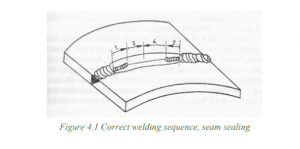Lesson 8: Repair welding of corrosion-resistant materials
In this lesson, we will explore the welding techniques and considerations when repairing corrosion-resistant materials commonly used in industries like food processing, pharmaceuticals, and chemical processing.
Introduction
- Corrosion-resistant steels find widespread use in industries where protection against corrosion is critical.
- The corrosion resistance of a material is determined by its ability to withstand corrosion without significant surface loss (typically less than 0.1 mm per year).
Characteristics of Corrosion-Resistant Materials
- Corrosion-resistant materials have specific characteristics:
- A uniformly sealed solid CrO layer covers the surface.
- The internal fabric structure is either homogeneous austenitic or ferritic.
Types of Corrosion-Resistant Materials
- Ferritic
- Low carbon content (max 0.1% C) and chromium content (12-18% Cr).
- Welding technology for ferritic materials requires specific preparation and preheating techniques.
- Martensitic
- Martensitic materials are used in applications like shafts, pins, knives, cutting tools, instruments, and turbine blades.
- Two types based on carbon content:
- Low carbon content (0.16-0.25% C) martensitic materials.
- High carbon content (>0.25% C) martensitic materials.
- Welding and post-welding treatments vary based on carbon content.
- Austenitic
- Austenitic materials have specific chromium (Cr), nickel (Ni), and carbon (C) content.
- They are commonly used in industries demanding high corrosion resistance.
Welding Techniques by Material Type
- Ferritic materials (KO1-KO6) require preheating and specific welding processes.
- Welding of martensitic materials (KO11-KO16) depends on carbon content and involves preheating and tempering.
- Austenitic materials (C 0.03-0.07%, 18-30% Cr, 8-30% Ni) have their own unique welding considerations.
Welding Technology for Ferritic Materials
- Preparation includes grinding out defects.
- Preheating to 200-350°C is essential to prevent grain hardening and cracking.
- Argon Arc Welding (AWI) for root welds, electrode-coated welding for filler welds.
- Air cooling and post-treatment (heating and cooling) are required.
Welding of Martensitic Materials
- Welding technique varies based on carbon content.
- Preheating and immediate tempering at specific temperatures are crucial to achieve desired properties.
Conclusion
- Repair welding of corrosion-resistant materials demands careful consideration of material type, carbon content, and specific welding techniques.
- Adherence to recommended procedures ensures the preservation of corrosion resistance properties.
